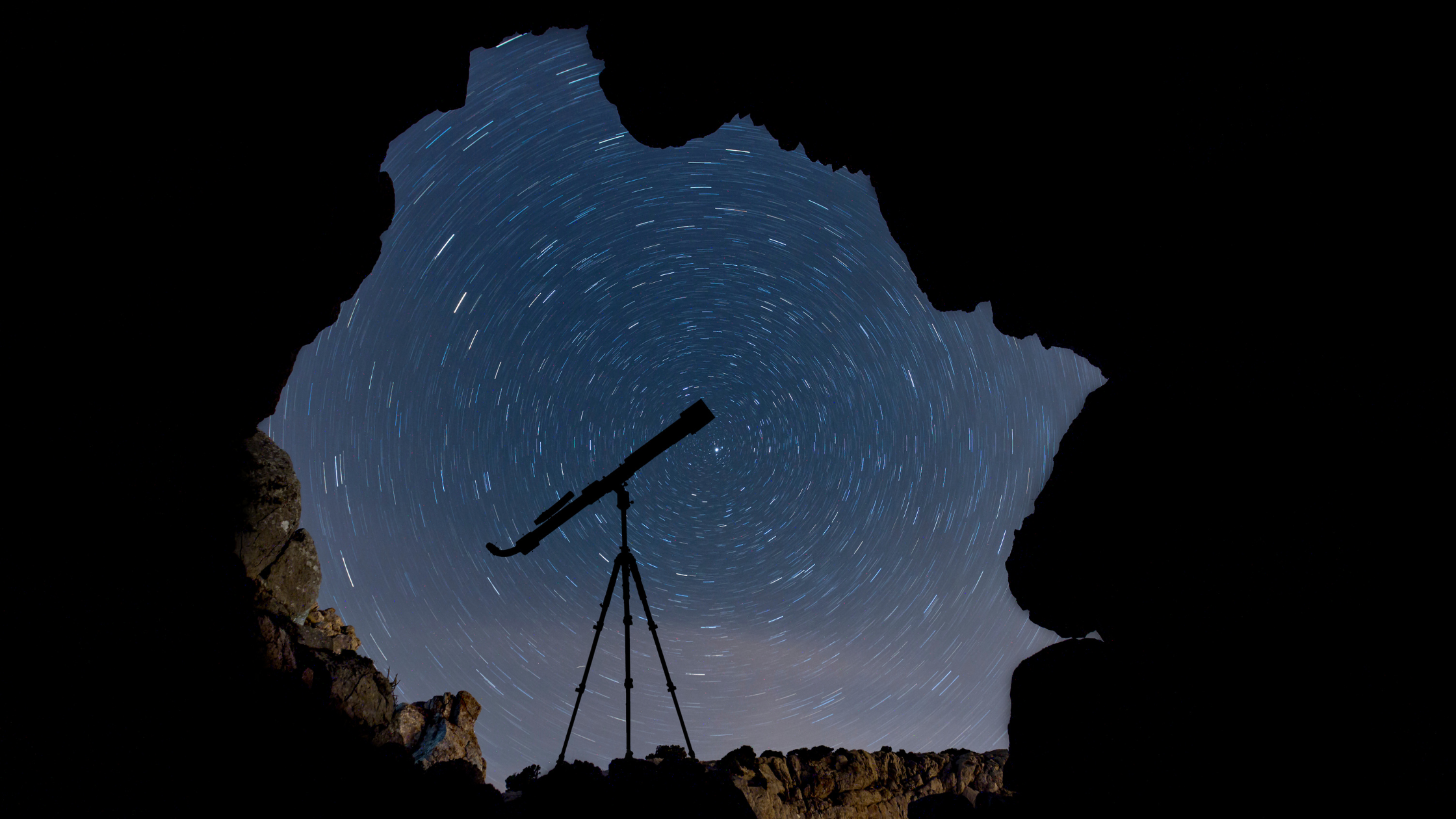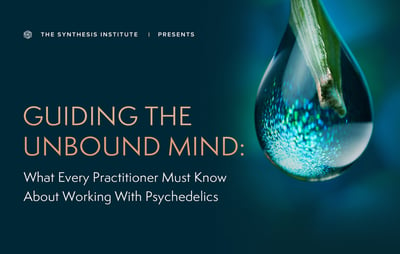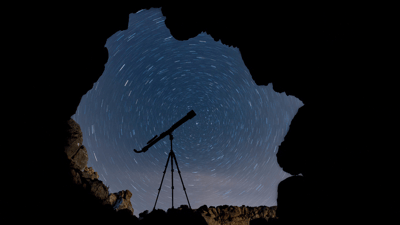This analysis of preliminary findings was conducted by Maria Amato in the Synthesis Institute’s Research Department and publicly presented at the Mind Foundation’s INSIGHT 2021 conference (video at the end of the article). Research was made possible thanks to our many retreat participants and our collaboration with researchers at the Centre for Psychedelic Research at the Imperial College of London.
From the very beginning in 2018, Synthesis has given participants the opportunity to contribute to scientific research as part of a collaboration with the Psychedelic Ceremony Study run by researchers at Imperial College London. This has resulted in several published articles, including research about the role of communitas in group ceremonies, eating disorders and metaphysical beliefs.
In the present analysis, close to 300 Synthesis participants were asked to complete online surveys two (2) weeks prior to their retreat, the day after their experience and, two (2) , four (4), and 24 weeks after their retreat. The aim was to produce a quantitative analysis of the experience that healthy participants have at Synthesis retreats by tracking any changes in mental health (wellbeing, depression, anxiety), connectedness, and personality, up to six months after their retreat.
Additionally, a second aim was to investigate potential reasons for the observed changes, specifically whether personality traits, factors associated with the acute experience during the ceremony, and integration activities could be related to the observed improvement in wellbeing.
Retreat Context in Brief
The Synthesis journey includes more than a psychedelic ceremony, which uses truffles containing psilocybin. The preparation and integration program includes intention setting, open-dialogue, bodywork, meditation, breathwork, psychedelic education, and 1:1 meetings, all led by professional facilitators.
Taking a group ceremonial approach, the psychedelic retreat incorporates elements from indigenous wisdom and contemporary science, such as curated music, sharing circles and embodiment practices.
Overview of the Study
Data were collected before and after each psychedelic session that took place during the retreats. This was a targeted enquiry, using validated psychometric measures, into:
- Mental wellbeing, depression and anxiety;
- Personality traits;
- Sense of connectedness;
- Emotional breakthroughs, mystical experiences, insights, sense of communitas, and other effects during and after the psychedelic journey.
Integration activities after the retreat were also assessed.
What did we observe?
An Increase in Wellbeing
After the retreat, we saw participants’ wellbeing scores increased by 14% on average at two weeks after their psilocybin experience, and remained increased by 13% at four weeks and 8% at six months (fig. 1)
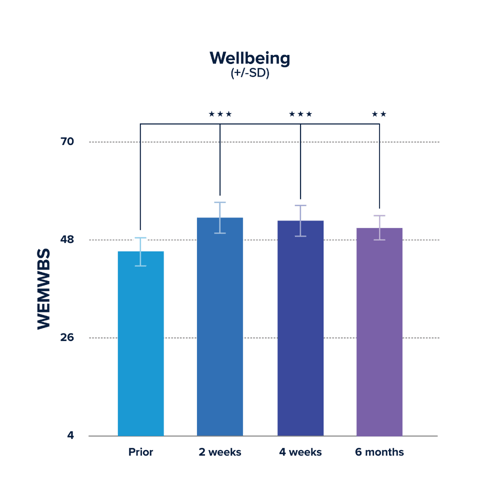
Fig. 1. Increase in wellbeing levels after the retreat. Asterisks represent the level of significance of the difference between each time point and baseline (**p<0.01, ***p<0.001).
WEMWBS = Warwick-Edinburgh Mental Wellbeing Scale, to assess wellbeing.
A Decrease in Depressive Symptoms
Depressive symptoms were 37% lower than baseline level two weeks after the psychedelic experience, decreasing even more by 43% at four weeks, and remaining lower compared to baseline at six months after the retreat at 34% (fig.2).
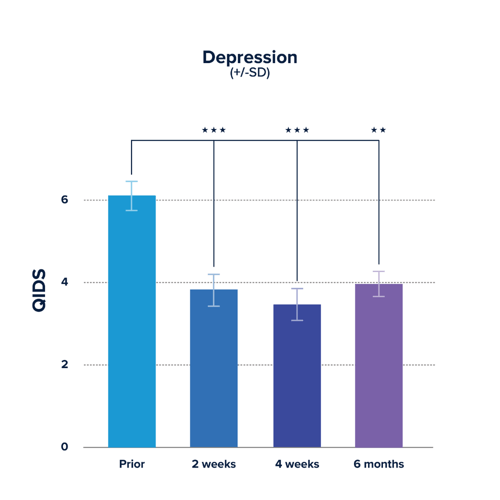
Fig. 2. Decrease in depression levels after the retreat. Asterisks represent the level of significance of the difference between each time point and baseline (**p<0.01, ***p<0.001).
QIDS = Quick Inventory of Depressive Symptomatology, to assess depressive symptoms.
A Decline in Anxiety
State anxiety reported by participants decreased by 17% two weeks after psilocybin, remaining lowered by 15% at the four week follow-up and by 11% after six months (fig. 3)
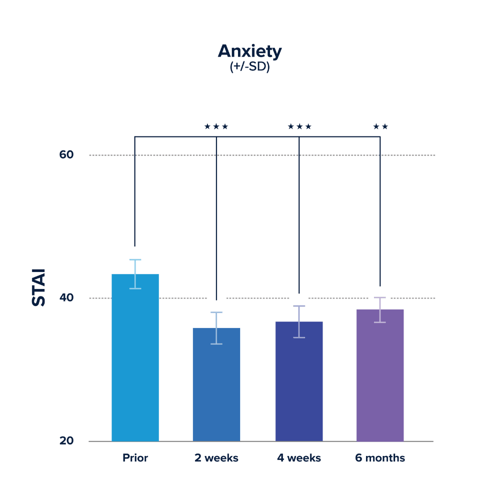
Fig. 3. Decrease in anxiety levels after the retreat. Asterisks represent the level of significance of the difference between each time point and baseline (**p<0.01, ***p<0.001).
STAI = Spielberger State-Trait Anxiety Indicator, to assess anxious symptoms.
Increased Feelings of Connection
The sense of connection that each participant experienced to themselves, others, and the wider world, increased by 33% at two weeks after the psychedelic experience, remaining 30% and 25% higher than baseline at the four weeks and six months follow-up respectively (fig. 4).
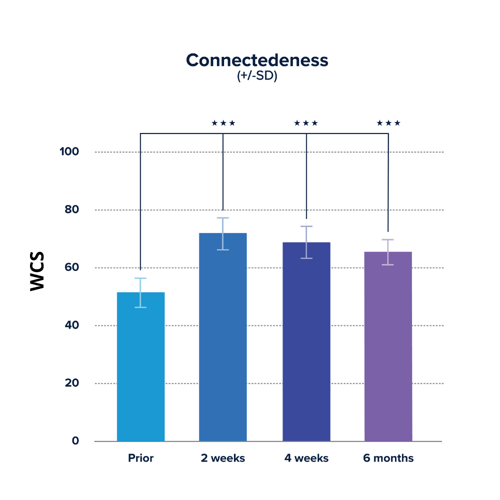
Fig. 4. Increase in levels of connectedness after the retreat. Asterisks represent the level of significance of the difference between each time point and baseline (**p<0.01, ***p<0.001).
WCS = Watts’ Connectedness Scale, to assess level of connectedness to self, others and the wider world.
Changes in Personality
Within the five subscales of the Ten-Item Personality Indicator (TIPI) assessment – openness, agreeableness, conscientiousness, extraversion, and emotional stability – we saw significant increases in agreeableness and emotional stability, and a smaller but still significant increase in extraversion at four weeks after the retreat (fig. 5). Agreeableness remained significantly higher than baseline at the six-month follow-up. We didn’t find a significant increase in openness and conscientiousness. This may be due to a ceiling effect, as most participants were already high in these traits at baseline.
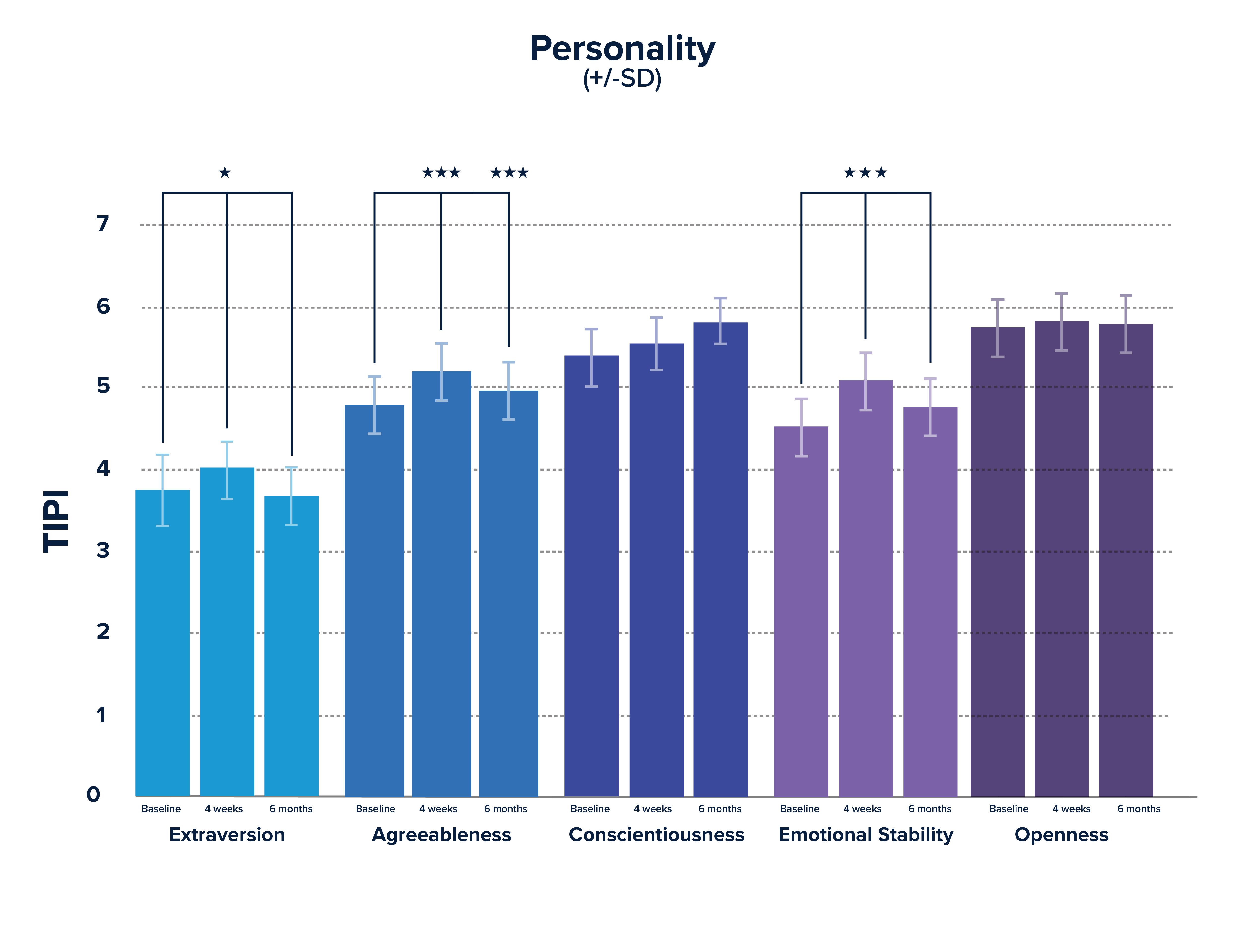
Fig. 5. Trend of the five main personality traits over time, prior to the retreat, four weeks after the retreat and six months after retreat. Asterisks represent the level of significance of the difference between each time point and baseline (*p<0.05,**p<0.01, ***p<0.001, ).
TIPI = Ten-Item Personality Indicator
How Did Personality Traits Predict Changes in Wellbeing?
In the first prediction model we investigated if the baseline personality traits were associated with the change in wellbeing over time.
Of all the baseline measurements, only emotional stability was a significant predictor of a change in wellbeing. More specifically, participants characterized by lower emotional stability at baseline were the ones showing the most increase in wellbeing after the retreat. This could partly be explained by the fact that those people had also a lower wellbeing at baseline; in other words, there was more room for improvement in wellbeing.
A closer look revealed that those were also the participants with the highest increase in emotional stability itself after the retreat, leading to the hypothesis that improvement in emotional stability after a psychedelic retreat in more emotionally unstable participants could be a key factor for reaching greater wellbeing.
How Did Aspects of The Psychedelic Experience Predict Changes in Mental Health?
Different aspects of the acute experience during the ceremony itself were found to be correlated to general improvements in wellbeing and anxiety, but not in depression. In the figure below (fig. 6) we can see that, in order of importance, the strongest correlations were emotional breakthrough, mystical experience, complex visuals, communitas and emotional synchrony.
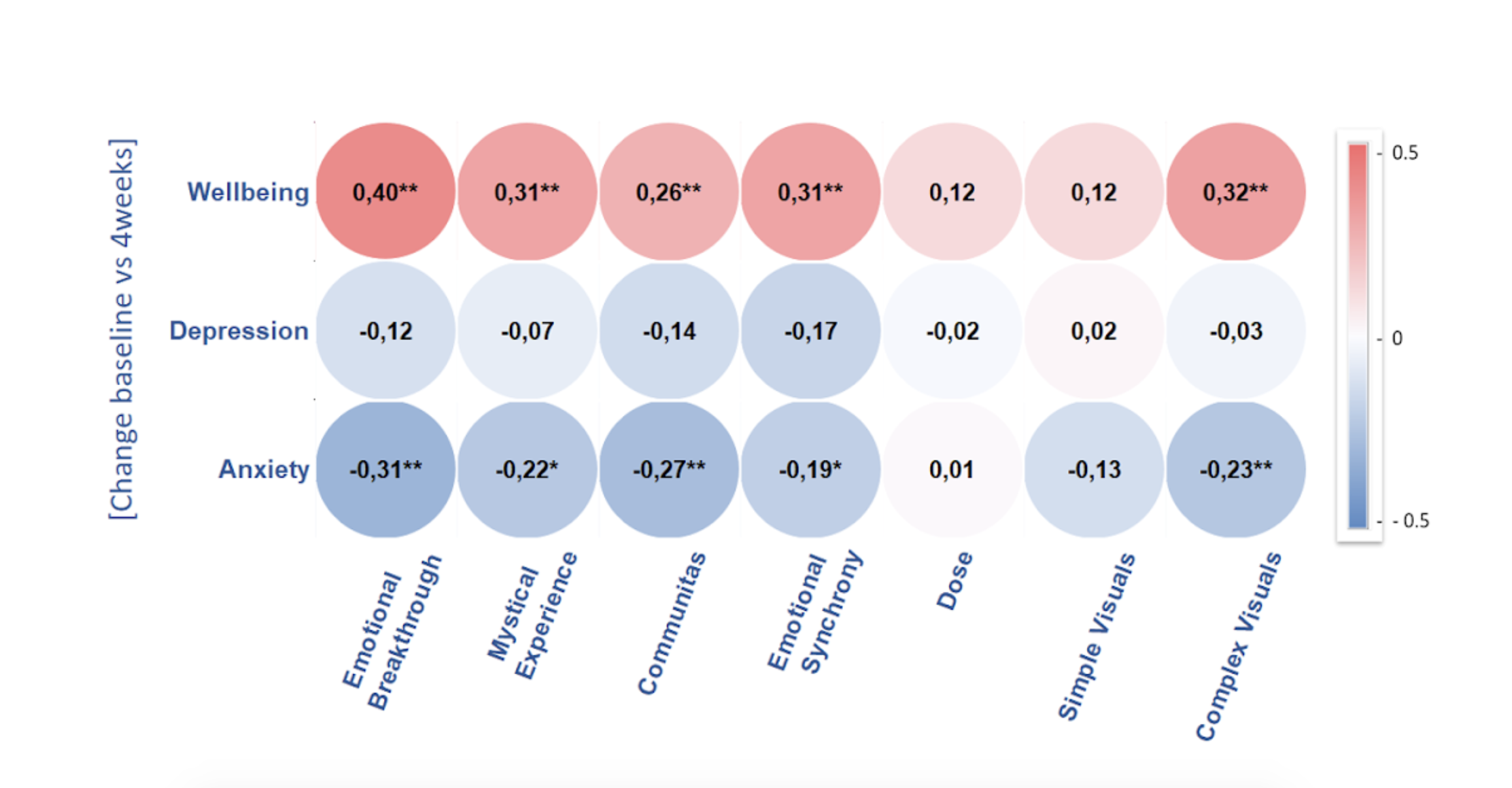
Fig. 6. Correlations between changes in quality of life four weeks after the retreat and factors of the acute experiences during the ceremony. Asterisks represent the level of significance of the correlations (*p<0.05,**p<0.01, ***p<0.001, ). The darker colors indicate stronger correlations between the acute experiences and the quality of life measurements, with the red gradient representing a positive correlation and the blue gradient representing a negative one.
The emerging factor from this analysis was emotional breakthrough (EB), which is described as facing emotionally challenging events, feelings, and past traumas by freely exploring them without resistance. In fact, when the contributions of all acute experience variables were accounted for, only emotional breakthrough emerged as a significant factor, explaining 17% of the improvement in wellbeing and 12% of the improvement in anxiety.
This is an important finding and supports what other studies in the past years already showed: experiencing an emotional breakthrough seems to be an important factor in explaining the improvement in quality of life observed after a psychedelic experience.
Integration Activities as Predictors of Mental Health Changes
We also tested whether certain behaviors and practices undertaken during the six-month follow-up period were associated with increases in wellbeing.
Four weeks after the ceremony, participants were asked if they engaged in any of the following activities:
- Conversations with close friends and family
- Psychotherapy, counseling
- Conversations with people that had a similar experience
- Spending time in nature
- Physical exercise
- Yoga, tai chi, qigong
- Religious practices
- Integration circles
- Journaling
Three variables that partly explained (14%) the observed improvements in wellbeing were having psychotherapy after the retreat, speaking with people who also had a psychedelic experience, and spending time in nature.
- Having psychotherapy or counselling during the month after the experience: This was the highest predictor of change in well-being. More specifically, people with lower wellbeing that engaged in this activity had a significantly higher absolute increase in wellbeing compared to the people with the same initial wellbeing level who did not engage in therapy after retreat.
- Engaging in conversations with people that had similar experiences: Given the intensity of such a transformative and, at times, transpersonal experience, it is possible to feel somewhat alienated from other people that haven’t had the same kind of experience. The present findings support the notion that having the possibility to share the journey openly and with trust with people that know what such an experience is like could be beneficial for the integration process.
- Spending time in nature: This finding is in line with the existing literature on the increase in nature-relatedness after using psychedelics. Like previous research, we also found an increase in nature relatedness in our dataset but, on top of that, unlike previous studies, we found a correlation between improvements in wellbeing and anxiety and changes in the sense of connection to and time spent in nature.
The role of integration activities was also tested against changes in depression and anxiety. In this case, for both outcomes, journaling was the only predictor of decreased depression and anxiety at the 4-week follow up.
Conclusions
In summary, this analysis shows that Synthesis participants exhibit increased wellbeing and connectedness scores, and enduringly reduced depression and anxiety, in the follow-up assessments up to six months after the retreat. Secondly, our findings suggest that important predictors of these observed long-term changes can be found in a wide range of different domains, spanning from the personality profile of our participants, to factors related to the experience in the ceremony itself, to different integration activities.
Given the naturalistic nature of this study, there are a number of limitations, namely the unstandardized psychedelic dosages, self-selection biases, the lack of a control group, the expectancy effect, and the number of dropouts at the later time points.
Moreover, it has to be emphasized that none of these findings imply causality, meaning that we can not conclude that journaling for example causes a decrease in anxiety. What we can conclude is that those integrative/acute experiences or personality traits are somehow related to the observed improvements, but that can be in both directions and in a direct or indirect way, i.e. mediated by other (unmeasured) factors.
This explorative analysis was the first internally produced scientific report by the Synthesis Institute. Preliminary findings like these are an indicator of the potential benefits of psychedelic retreats like those at Synthesis. However, these findings should not be interpreted as a suggestion that attending this retreat can serve as a treatment for depression or anxiety, but as a testament to the potential positive impact on a person’s overall wellbeing that attending a psychedelic ceremony can have.
This report should also be considered as a preliminary exploration of the Synthesis dataset of the Ceremony Study as it has not been subject to peer-review. More research is needed to fully understand how contemporary psychedelic retreats can support the healing, wellbeing and personal growth in future participants.
Watch this video to see Maria Amato present her research at INSIGHT Conference:







